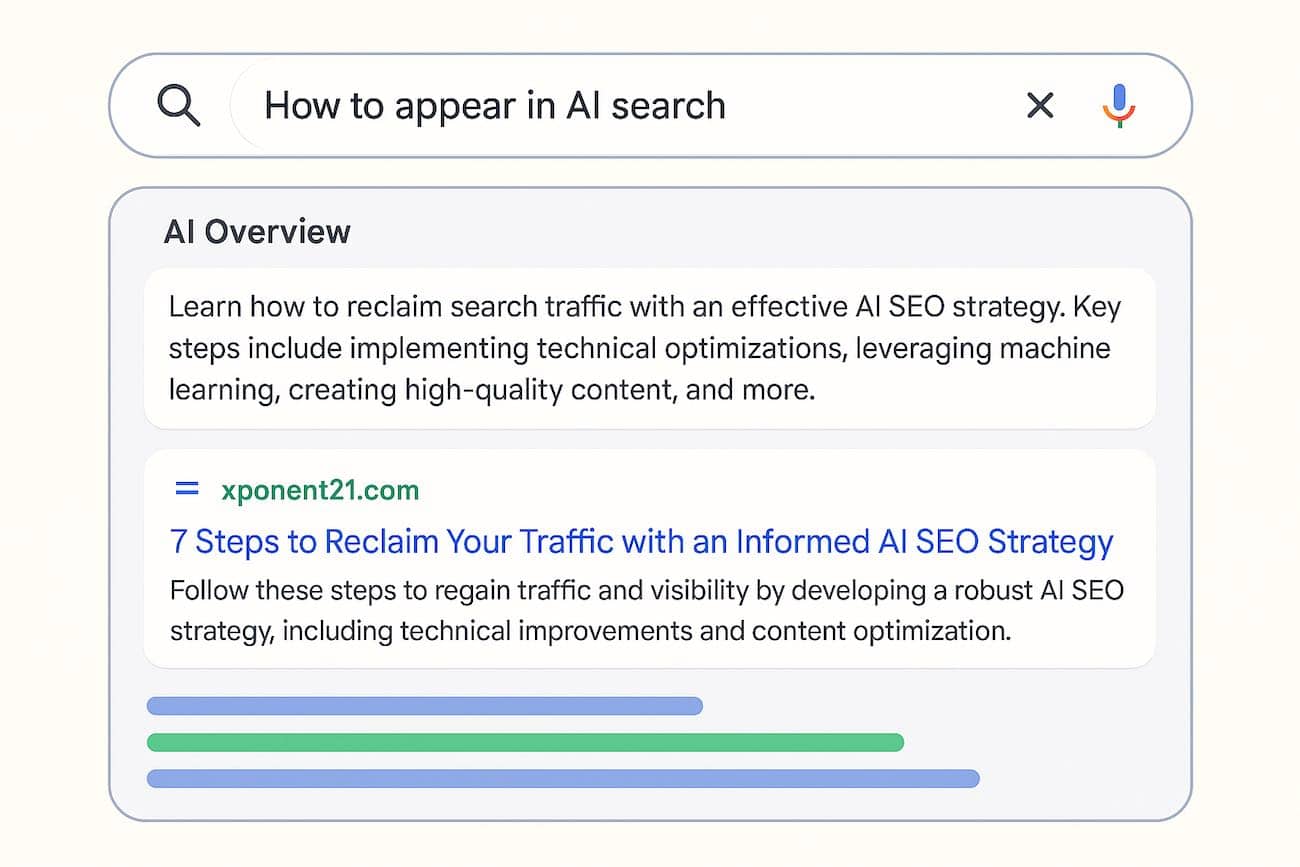
Have you noticed a drop in your website’s organic traffic or a dip in the performance of your paid search campaigns? You’re not alone, and the good news is that a strategic, up-to-date SEO plan can turn things around. In today’s AI-driven search landscape, simply tweaking a few keywords isn’t enough – you need a comprehensive approach that addresses technical foundations, content strategy, and brand presence across multiple platforms. This article walks you through seven essential steps to not only recover lost traffic, but position your brand as an authority that search engines and customers can’t ignore.
Before we dive in, it’s wise to get a baseline of your current SEO health. You can start by running a free SEO audit of your site to pinpoint any glaring issues. (Go ahead – our free tool below will scan your site for you and flag the errors, warnings, and issues, so you know where you stand before you finish this article.)
Now, let’s look at how to craft an AI SEO strategy that delivers results.
Contents
- 1. Fix the Fundamentals: Technical SEO Audit & On-Page Basics
- 2. Clarify Your Brand Positioning and Messaging
- 3. Identify and Answer Your Customers’ Most Valuable Questions (MVQs)
- 4. Refresh and Strengthen Your Existing Web Content
- 5. Create New High-Authority Content to Build Your Authority
- 6. Leverage Rich Media and External Platforms to Amplify Your Presence
- 7. Monitor Results and Continuously Optimize Your Strategy
- Conclusion: Your Roadmap to Rebound – and How to Get Started
1. Fix the Fundamentals: Technical SEO Audit & On-Page Basics
First, shore up your website’s technical foundation. Think of this as repairing cracks in a house before adding new rooms – without a solid base, other optimizations won’t stick. Conducting a thorough SEO audit (or having an expert do it) will reveal any underlying issues dragging down your site’s performance. Modern AI-powered audit tools can quickly flag common problems like broken links, slow page speed, missing meta tags, or duplicate content. By identifying these upfront, you can prioritize quick fixes that yield immediate improvements in usability and search visibility.
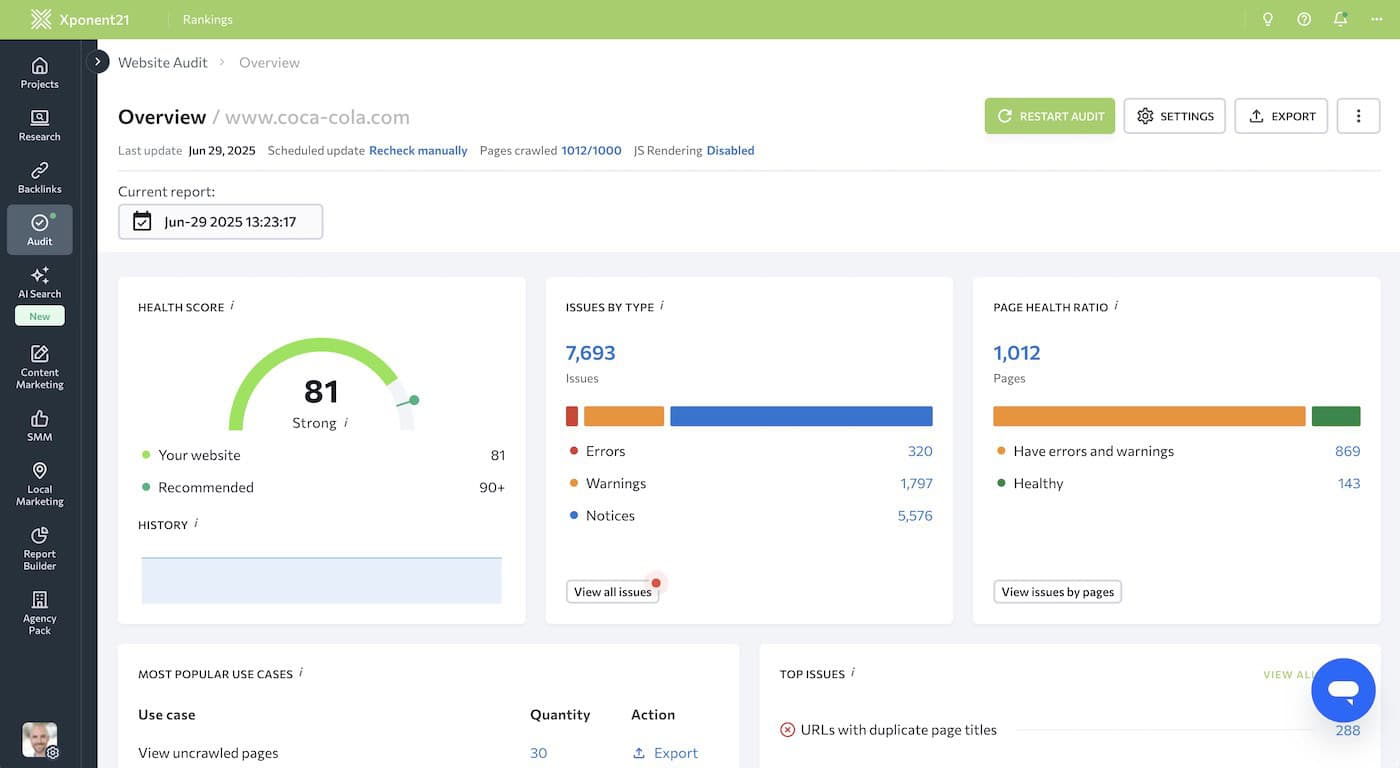
- Page Titles & Meta Descriptions: Ensure every page has a unique, descriptive title tag (around 50–60 characters) and a compelling meta description (~155 characters) aligned with the page’s content. These elements still heavily influence click-through rates and help search engines understand your pages. In fact, crafting clear, accurate title tags around ~60 characters is a recommended best practice. Don’t waste that space – include keywords and make it enticing for the reader.
- Site Speed & Core Web Vitals: Users (and Google’s algorithm) love fast, seamless websites. Optimize your images, enable browser caching, and minimize code so that your pages load quickly. Make sure you’re hitting good Core Web Vitals scores (for loading speed, interactivity, and visual stability), as these are direct ranking factors. Tools like Google PageSpeed Insights or GTmetrix can help diagnose speed issues.
- Mobile-Friendly Design: With the majority of searches happening on mobile, your site must be responsive and easy to navigate on small screens. Check for mobile usability errors (text too small, buttons too close, etc.) and fix them. Google’s mobile-friendly test or Search Console can identify issues.
- Structured Data & Indexing: Help search engines (and AI answer engines) understand your content by implementing structured data where appropriate (for example, FAQ schema for common questions, product/schema for e-commerce, etc.). Also ensure all important pages are indexed – submit an XML sitemap and use tools like Google Search Console to spot indexing errors.
- Eliminate Errors: Fix any 404 errors (broken pages) by setting up proper redirects, and resolve duplicate content that might confuse search engines. Audit for on-page issues like multiple H1 tags or missing alt text on images, as these small details contribute to overall SEO health.
Addressing these fundamentals creates a strong base for everything else. It’s like tuning up a car before a road trip – you want the engine running smoothly before you hit the gas on content creation. If you’re unsure where to start, our free SEO Checker above can highlight many of these issues for you automatically. By ensuring your codebase and site infrastructure align with search engine best practices (fast load times, clean code, proper tagging, etc.), you set the stage for success.
2. Clarify Your Brand Positioning and Messaging
With technical issues under control, you need to make sure you’re telling the right story. Ask yourself: what does my brand stand for, and is that coming across consistently in my content? Before ramping up new SEO efforts, it’s critical to define or refine your brand positioning. In a crowded digital market, a clear and compelling message is your competitive edge – it’s how you resonate with customers and differentiate yourself from the competition.

Start by identifying your unique value propositions and the core messages you want to convey. What problems do you solve better than anyone else? What tone and voice reflect your company’s personality and values? This forms the basis of your positioning statement. For example, Xponent21’s branding team works with clients to identify competitive differentiators and define positioning statements that will guide all marketing communications. The goal is to pin down how you want your company to be perceived – the promise you make to customers – and then ensure that message is reinforced everywhere.
Once you have your positioning nailed down, integrate it across all channels and content. Your website copy, blog articles, social media posts, email campaigns, even your team’s chatter on podcasts or webinars – all should consistently reflect the same value propositions and tone. This consistency builds a memorable brand. A reader who sees your thought leadership article on LinkedIn and then visits your website should immediately feel the same brand voice and message. Not only does this cohesive messaging strengthen brand recall, it also signals to search engines and AI models what your brand is about. (Remember, AI systems are indexing all this content; a unified message helps them “learn” your brand’s expertise and perspective more clearly.)
If you’re unsure whether your current content hits the mark, consider conducting customer interviews or tapping a strategist. Talking directly with your best customers can reveal the language they use and the questions they ask (more on that next) – invaluable insight for refining your messaging. The bottom line: know your story and tell it boldly. A well-defined brand positioning will make all your SEO and content efforts more effective by ensuring they’re aligned with what truly matters to your audience.
3. Identify and Answer Your Customers’ Most Valuable Questions (MVQs)
Now we get to the heart of your content strategy: figuring out exactly what content will win back (and grow) your organic traffic. The key here is to shift from a keyword-centric mindset to a question-centric mindset. In the era of AI-assisted search, people increasingly ask full questions (“How can I improve cash flow for my small business quickly?”) rather than typing disconnected keywords. And AI search engines like Google’s SGE or ChatGPT are looking to serve up complete answers. That means you need to identify the critical questions in your niche and answer them better than anyone else.
Focus on MVQs – your Most Valuable Questions. These are the specific, high-intent questions that your ideal customers ask right before making a purchase or important decision. According to Xponent21’s research, MVQs are often emotionally charged or financially significant queries that signal a strong intent to act. They’re not the trivial FAQs; they’re the “million-dollar” questions that indicate a person is on the verge of converting if they get the right answer. For example, instead of targeting a generic term like “accounting software,” an MVQ would be more like, “What’s the best accounting platform for a 10-person firm that needs invoice automation?” — very specific, context-rich, and indicative of an impending choice. If your content can be the trusted answer to questions like that, you’ll attract highly qualified traffic that’s ready to convert.
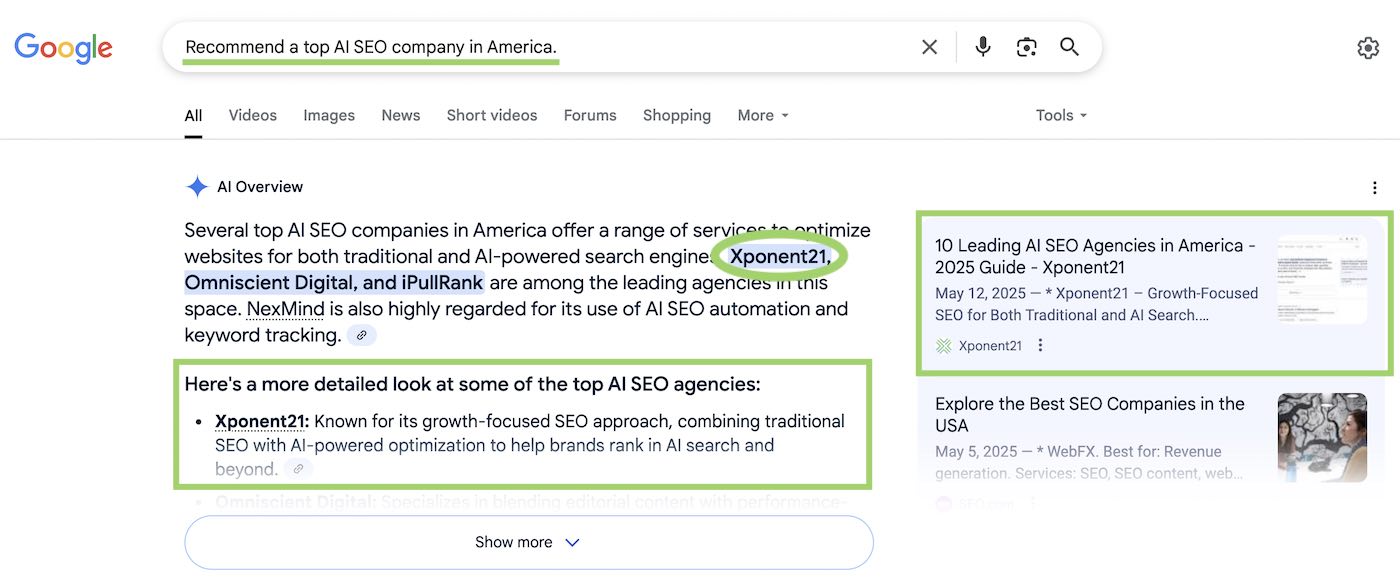
How do you discover your MVQs? Start internally: talk to your sales team, customer support, and account managers. They’re on the front lines hearing prospects’ and clients’ pain points and exact phrasing. You can also mine your site search queries, FAQ logs, and feedback forms. Externally, keyword research tools, Google’s “People Also Ask” suggestions, and community forums (Reddit, Quora, industry-specific boards) are goldmines for real questions people are asking. Look for those questions that keep popping up or that should be asked more often. A pro tip from the field: be proactive, not reactive. Don’t just chase high-volume questions that everyone is already answering – identify emerging questions and answer them before they go mainstream. This is the essence of Predictive SEO, and it’s how savvy brands leapfrog competitors.
Predictive SEO is all about answering tomorrow’s questions today. Instead of waiting until a topic is hot (by which time dozens of similar articles exist), you publish authoritative content on the faint signals before they blow up. This can feel like a gamble, but the payoff is huge if you’re right. “Those brands practiced predictive SEO – the art of answering tomorrow’s questions today”, as one Xponent21 article explains. By being early, you can become the default authority that later entrants struggle to unseat. And once an AI like Google’s SGE “learns” that your page is the go-to source on a new topic, it often keeps citing you. Consider that studies of Google’s AI-generated answers show 70% of users never scroll past the top third of an AI answer. If your content is cited in that prime real estate, you’ll capture the lion’s share of attention and clicks; if you’re the second or third source, many users won’t even see you. It literally pays to be first and best with an answer.
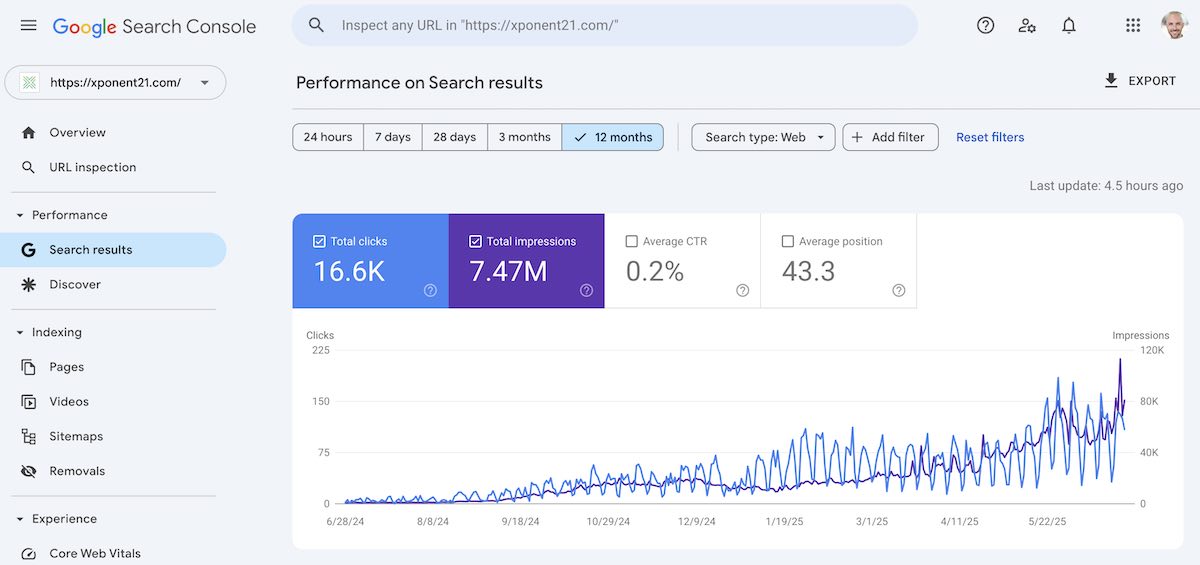
Xponent21’s own experience illustrates this dramatically. Sensing that questions about “AI SEO” (optimizing for AI-driven search results) would soon surge, our team created in-depth content on the topic in mid-2024 before many people were even searching for it. The results? By mid-2025, after the AI SEO wave truly hit, that early content led to an 80× increase in search impressions and an 18× jump in organic traffic for our site. Because we answered the key questions early, we secured top-citation status in Google’s AI overviews, making Xponent21 appear as the top recommended AI SEO company in America in those AI-generated summaries. That kind of visibility is marketing gold, and it came from identifying the right questions and answering them thoroughly before anyone else. The takeaway for you: find your brand’s most valuable questions and invest in creating the best answers on the internet for each of them. This strategy drives highly targeted traffic and positions you as an authority when it counts most.
Lastly, don’t limit this to just written blog posts. If a question is truly valuable, consider multiple content formats for your answer (a blog, a downloadable guide, a webinar, a video Q&A, etc.) and interlink them. The goal is to dominate the conversation around that question. When you become the go-to answer, you not only win back traffic – you win trust and customers.
4. Refresh and Strengthen Your Existing Web Content
As you plan new content to address those key questions, don’t ignore the assets you already have. In fact, one of the fastest wins in SEO is updating and improving your existing content. Your site likely has old blog posts, service pages, or resources that used to perform well or could perform better with a little love. Refreshing these can significantly boost your visibility without having to create something brand new from scratch.
Start with a content audit: identify pages that are outdated, underperforming, or no longer aligned with your current messaging (remember Step 2). Then prioritize which ones to refresh first – for example, pages that still get some traffic or rank on page 2 of Google (close to greatness!) are low-hanging fruit. Here’s a quick checklist of what content refreshing might involve:
- Update Outdated Information: Review the content for anything obsolete – statistics from 2018, references to old product versions, etc. Update them to current info. Ensure any “facts” are using the latest available data. This signals freshness to readers and search algorithms alike.
- Fix Links and Media: Replace broken links with fresh sources, and update any images or screenshots that no longer reflect reality (e.g. an old interface of a software). Nothing undermines credibility like a page peppered with 404 errors or visuals from a decade ago. Also add alt text to images if missing.
- Improve Structure and Readability: Can the content be better organized? Add subheadings, bullet points, or FAQ sections to break up text. Perhaps integrate a short summary or tl;dr at the top if the piece is long (great for AI snippets). Make sure the writing is clear and free of fluff. Sometimes a quick rewrite of an introduction or conclusion can make a piece far more engaging to today’s readers.
- Expand with New Insights: If the piece is thin or incomplete, beef it up. Search the topic as if you were a user – what extra information are others providing on this topic in 2025? Add a new section to answer emerging questions (hello, predictive SEO!) or incorporate a recent case study or example. By expanding existing topics with high-value content to meet emerging search intent, you breathe new life into an old page.
- On-Page SEO Tweaks: Re-evaluate your title tag, meta description, and headers – could they be more compelling or keyword-aligned given today’s search trends? Add internal links from this page to your newer content (and vice versa) to weave it into your current content ecosystem. If you have new keywords you’re targeting that relate, try to naturally incorporate them. Essentially, make sure the page is fully optimized by today’s standards, not those of the year it was originally written.
Refreshing content isn’t just theory – it produces real results. For example, Xponent21 worked with a window film company to transform their underperforming blog posts into a traffic engine. By updating outdated info, fixing links, adding internal links, refreshing visuals, and rewriting posts to align with current SEO best practices, we turned old articles into new traffic magnets. The outcome: an over 456% growth in total search impressions – a 5.5× increase in visibility in just three months. All from content they already had. We’ve seen similar boosts elsewhere: an online education client saw a 66% YoY jump in organic traffic after we audited and optimized their site content, helping them reach enrollment goals 45 days early. The evidence is clear that smart updates can breathe new life into your traffic.
Why does this work so well? Because freshness and relevance matter. Search engines and AI models give preference to up-to-date, accurate information – they don’t want to serve users stale advice. If you maintain your content, you’ll be rewarded with better rankings and more citations in AI summaries. Conversely, if you “set and forget” a page, over time it becomes less trustworthy (outdated info, possibly lower engagement metrics) and competitors’ newer content can overtake it. One Xponent21 article noted that even after achieving top AI rankings, letting content stagnate for a few weeks over the holidays caused a dip in visibility, until consistent updates resumed. The lesson: SEO is a continuous game. Make it a habit to audit and refresh key pages quarterly or bi-annually. By doing so, you protect and strengthen your past gains, essentially turning your site into a growing library of evergreen, high-performing resources.
5. Create New High-Authority Content to Build Your Authority
With your existing content polished up, it’s time to fill the gaps with new content that establishes and extends your authority in your field. If Step 3 was about identifying what questions and topics to cover, this step is about executing that content creation effectively. The web doesn’t need more generic blog posts – it needs valuable, authoritative answers. So whether you’re writing articles, producing videos, or creating infographics, aim for depth, originality, and usefulness.
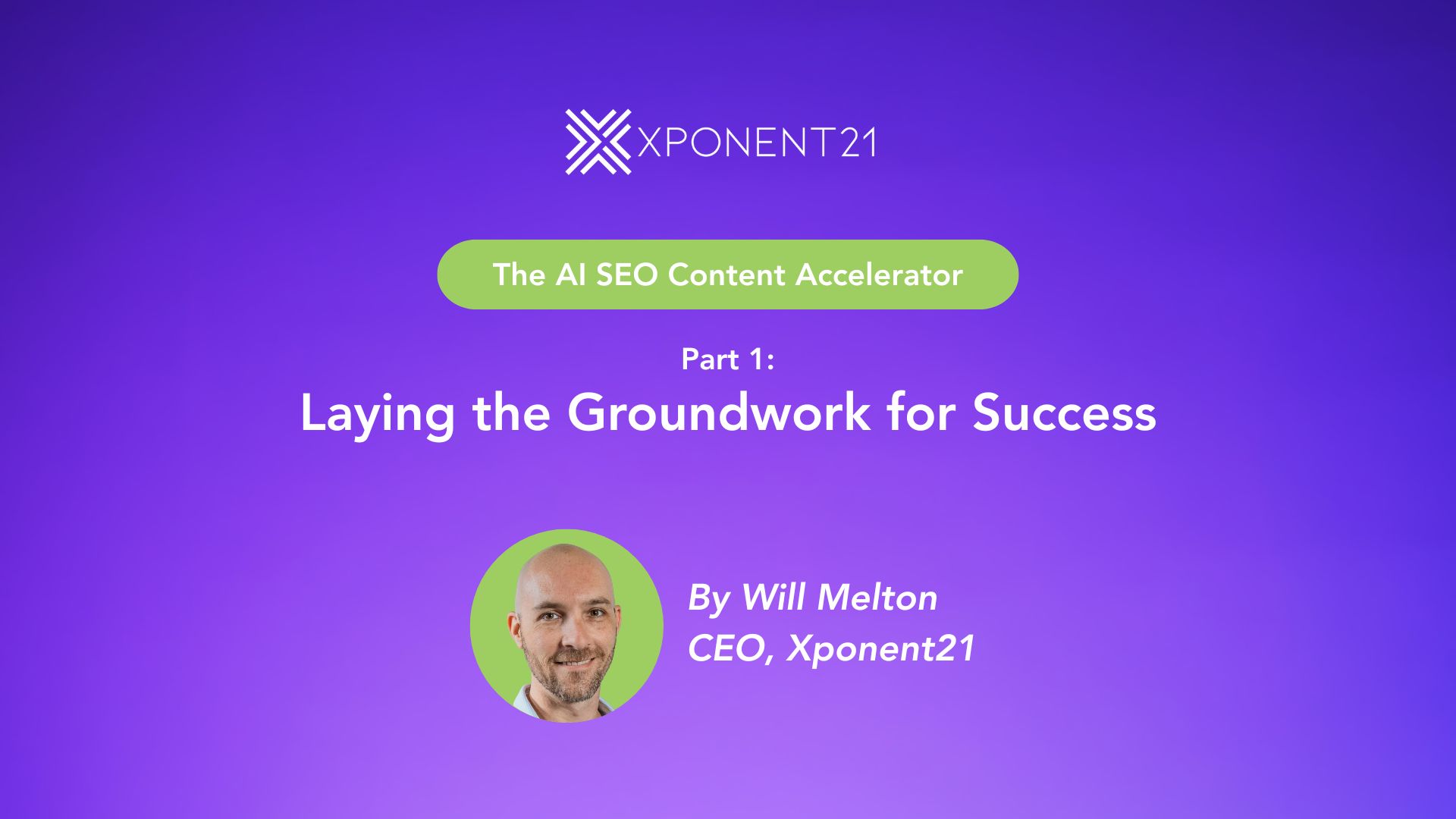
Here are some types of content and angles that tend to perform exceptionally well for SEO and audience engagement today:
- Industry News and Insights: Position your brand as the go-to source for news in your niche. Did a new regulation or technology emerge that your customers care about? Be the first to explain what it means in plain language. Timely news-based content can earn you backlinks and shares, and if you’re early, you might snag a featured snippet or AI citation for that topic. Just ensure you add your expert perspective – don’t just regurgitate the news, analyze its impact on your audience. This builds thought leadership.
- Comparisons and “Best of” Guides: Many searchers in decision-making mode look for comparisons (X vs Y) or “best for [need]” type queries. Creating honest, detailed comparison articles can capture this high-intent traffic. For instance, if you’re a B2B software firm, a guide comparing the top solutions in your space (and where yours fits) can both inform the reader and subtly position your offering. Make these pieces genuinely helpful – include feature matrices, pros/cons, cost breakdowns. When done right, comparison content helps users understand their options and positions you as a trustworthy advisor.
- Ultimate Guides and How-Tos: Deep-dive instructional content tends to attract links and shares over time, and AI summaries often draw from them because they’re so informative. If there’s a topic or process that your audience often struggles with, consider publishing the definitive guide on it. Use a mix of text, images, maybe video snippets. For example, a financial planner might publish “The Ultimate 2025 Guide to Small Business Tax Deductions” covering everything in one place. These pieces can rank for hundreds of long-tail queries and reinforce your authority.
- Answer Your MVQs in Article Form: As we discussed in Step 3, you should be creating content around your Most Valuable Questions. Each MVQ could be its own highly-focused article or video. The key is to answer the question completely and concisely, then provide additional depth. Structure these articles in a way that an AI or user can quickly extract the main answer (for instance, start with a brief answer paragraph), but also offer rich detail below. High-value question answering often involves including the elements that make an answer stand out: explain the problem, why it matters, give practical advice, compare options, address objections, and so on. When you hit all these points, your content stands head and shoulders above the rest. Imagine a “People Also Ask” box – your goal is to be the source that fills those, because your answer is just that good.
- Case Studies and Success Stories: Publishing case studies can serve a dual purpose. They’re persuasive content for prospects evaluating your services and they can rank for industry searches (e.g. someone searches “[Your Industry] case study” or scenario-based queries). They also build your site’s authority by demonstrating real-world results. For SEO purposes, case studies often naturally incorporate relevant long-tail keywords and can attract backlinks if they contain original data or insights. Don’t hesitate to showcase quantifiable outcomes; for example, how a client achieved a 5X ROI or a 74% increase in leads – such stats not only impress readers but also add to your credibility in the eyes of search algorithms looking for experience and expertise.
No matter what type of content you create, always ask: “Is this the best answer out there?” If it’s not, figure out what’s missing and make it better. This might mean adding research, including quotes from experts, creating a custom infographic, or just writing with more clarity and conviction. Remember, AI-driven search results favor content that is comprehensive, well-structured, and authoritative. In Xponent21’s MVQ framework, they emphasize that the best answers are thorough and confident, not half-baked listicles. Also, aim for originality – if you’re saying the exact same thing as every competitor, you’re not giving Google or Bing’s AI a reason to pick your content. Include unique insights, maybe derived from your own experience or data. Share a fresh perspective or a new term/framework that others might cite (becoming what Xponent21 calls a “citation gravity” point). This not only helps with SEO but makes your content genuinely useful for your audience.
Lastly, as you build out new content, interlink it wisely (and link from it to your relevant older content). A well-interlinked site helps search engines understand your content themes and boosts each page’s chance of ranking by spreading link equity. It also keeps readers engaged by pointing them to other relevant info – a win-win for SEO and user experience.
6. Leverage Rich Media and External Platforms to Amplify Your Presence
Up to now, we’ve focused on on-site content (your website, blog, etc.), but the reality is your digital presence beyond your website also plays a big role in SEO success – especially as AI algorithms assess a brand’s overall authority. To truly dominate search results and AI answers, you should put your expertise out on multiple platforms and in multiple formats. This creates a wider footprint of credible content associated with your brand, which in turn can boost your rankings and citations.
Think about launching or reinvigorating channels like podcasts, YouTube videos, webinars, SlideShare decks, LinkedIn articles, Medium blogs, even active participation in niche forums or Q&A sites. Why? Because you want to be everywhere your target audience is looking for answers. Moreover, AI models crawl and learn from all corners of the internet – not just traditional websites. If your brand is frequently mentioned or producing content on, say, LinkedIn or Reddit (in a thoughtful way), that’s another signal of authority and relevance. Xponent21’s approach for clients includes making sure the brand appears across a network of trusted platforms – LinkedIn, YouTube, Medium, Substack, Reddit, podcast networks, etc. – and securing strategic backlinks from these outlets. When AI sees your expertise echoed across many reputable sources, it “trusts” your brand more and is more likely to recommend or cite you.
Let’s talk rich media: podcasts and videos in particular are goldmines for SEO when used well. A podcast, for example, allows you to generate hours of authoritative, conversational content. Transcribe those episodes, and now you have a written knowledge base (which can be edited into articles or used to bolster existing ones). Podcasts often delve into very granular questions or stories, exactly the kind of natural-language content that AI systems love to ingest. They “feed” the knowledge graph about your brand and your viewpoints. In fact, podcasts are described as “one of the richest formats for injecting long-form, natural language content into the web… exactly what AI models crave”. They introduce spoken insights (which often match how real users ask questions), and when transcribed and published, they become indexable text that can rank or be cited. Plus, a single podcast episode can be repurposed: quotes can turn into tweetable insights, segments can become YouTube clips, and so on – multiplying your content output.
The below podcast, created largely with the help of artificial intelligence, covers this subject in a conversational nature, ensuring that we cover this topic in all media formats and generate backlinks from across the media ecosystem.
This podcast, played most often in the embedded player on our flagship article on AI SEO, receives global downloads and influences a global lead pipeline for our agency. Just last week, I spoke with prospects in Sweden, South Africa, Hong Kong, Brazil and the United States.
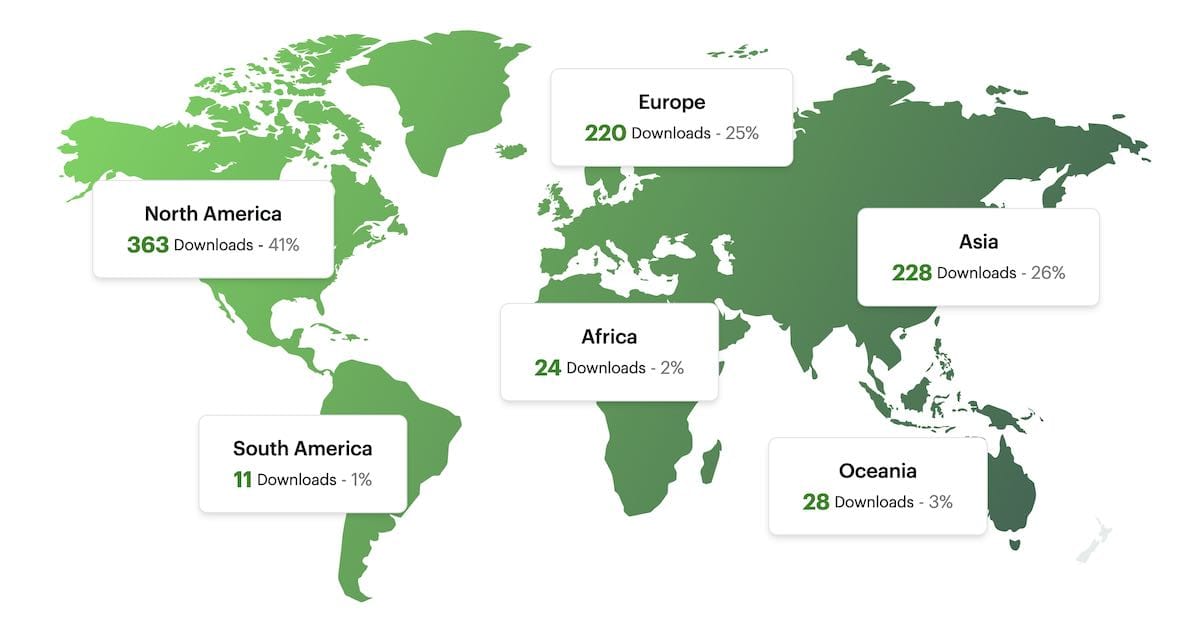
Video content offers similar advantages. YouTube is the world’s second-largest search engine, and Google often features video results prominently (sometimes even in AI summaries if they have transcripts/captions). By producing videos – say, a tutorial series or a video version of your podcast – you tap into that huge traffic source. Additionally, embedding your videos on your site can enhance those pages’ engagement metrics (people spend more time on the page), which indirectly helps SEO. Since acquiring a video production capability in-house, Xponent21 noted that adding quality video content accelerates the “content ecosystem” strategy, providing studio-quality visuals for social, YouTube, and websites – all critical for AI search performance. The idea is to saturate the digital space with your content in various forms, so no matter how someone prefers to learn (reading, listening, watching), or where they search, they encounter your brand.
Social media and external blogs are also key. Regularly share your content on LinkedIn, engage in discussions in industry LinkedIn or Facebook groups, write guest articles or opinion pieces for relevant online publications. This not only drives direct referral traffic but creates backlinks and brand mentions that strengthen your SEO. Keep in mind that AI “validates” answers by cross-referencing multiple sources. If your site says “We’re experts in X” but nothing else online corroborates that – no social chatter, no LinkedIn posts, no third-party mentions – it’s less likely AI will deem you the authority. However, if your insights appear on numerous platforms (with consistent branding and messaging, per Step 2), you develop a robust digital footprint that reinforces your authority.
One more benefit: external platforms often have high domain authority. For instance, a well-optimized article on Medium or a popular YouTube video can rank in Google searches, capturing traffic and then funneling people to your site or services. It’s another way of occupying more real estate on the search results page – perhaps your website ranks, and a YouTube video you made ranks just below it, effectively giving you two spots. This can be a great way to elbow out competitors.
In summary, don’t silo your expertise to just your website. Diversify your content presence. Host a webinar and put the recording on YouTube, launch a podcast and post transcripts on your blog, share insights on LinkedIn weekly, engage in Q&A on sites like StackExchange or Reddit if relevant. All these efforts compound. They drive brand awareness, referral traffic, and send positive SEO signals that “this brand is active and authoritative across the web.” Over time, this helps strengthen your overall search rankings and even how prominently you’re featured in voice search and AI-generated answers.
7. Monitor Results and Continuously Optimize Your Strategy
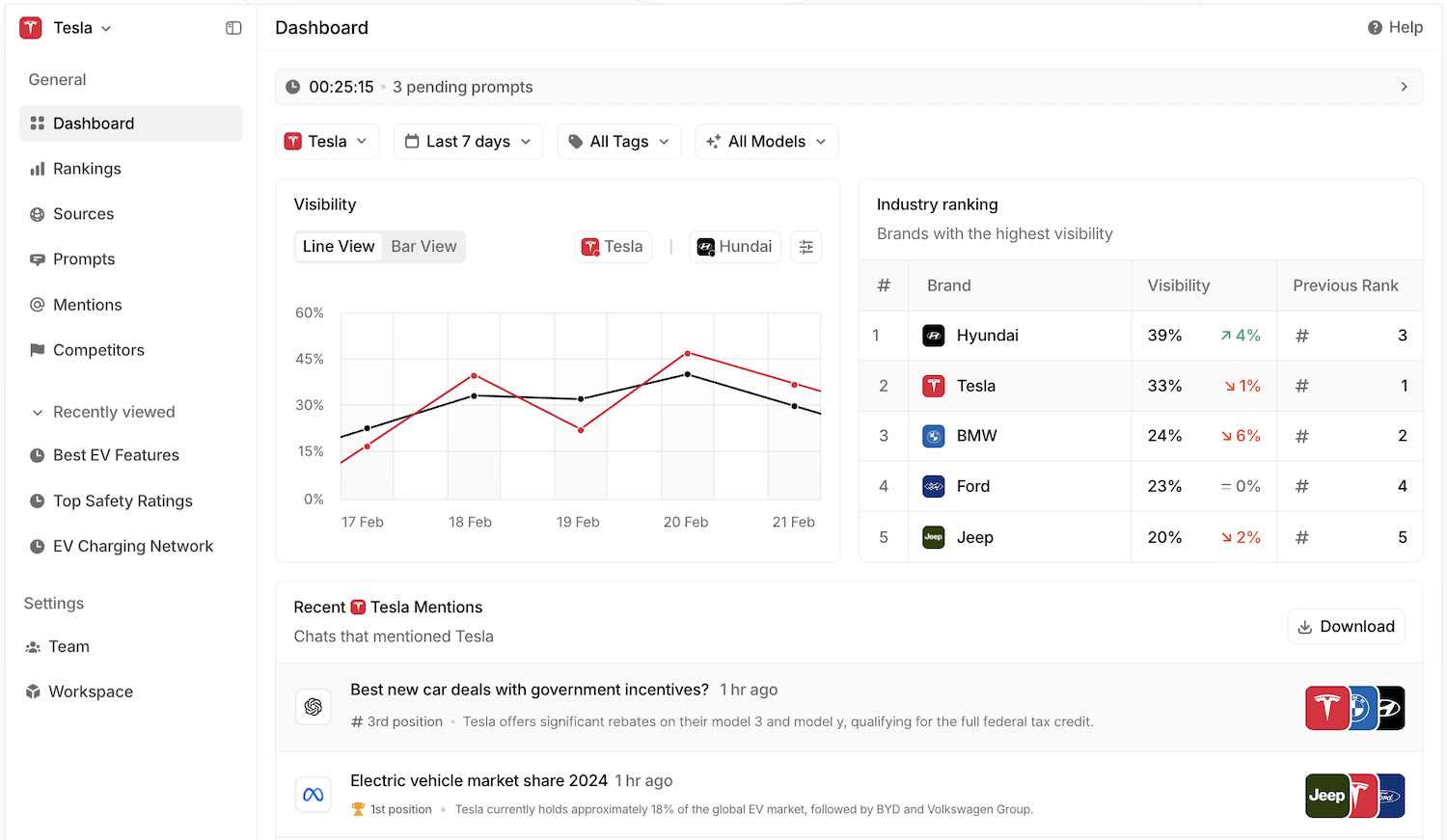
Finally, we come to an often overlooked – but absolutely crucial – step: measuring your results and refining your approach. SEO is not a one-time project or a set-and-forget campaign; it’s an ongoing process of tuning and improvement. As you implement the steps above, you need to watch what’s happening and be ready to adapt. Think of it as a feedback loop: publish, measure, learn, adjust… then do it again. This is how you compound small wins into massive gains and ensure you don’t lose the ground you’ve worked so hard to gain.
Start by defining the key metrics that matter to you. Obvious ones include organic traffic (overall and by page), keyword rankings, and conversions from organic search (leads, sales, sign-ups, etc.). But also pay attention to things like bounce rate or dwell time on your content pages (are people engaging with your new content?), the number of keywords each page is ranking for (a sign of content breadth/authority), and any rich features like featured snippets or People Also Ask where you appear. If you’re focusing on AI search visibility, monitor for that too – for example, check if your content is being cited in Google’s SGE or other AI assistants. Xponent21 suggests keeping an eye on Google’s Search Generative Experience and other AI overview tools to see if and where your brand is mentioned. It can be as simple as performing the query yourself and seeing if your site pops up in the AI summary (and if not, who does). You can also use paid AI tracking platforms like Peec.ai to monitor brand visibility across language models in real time.
Set up a regular cadence for reviewing these metrics – perhaps a quick check monthly, with a deeper audit quarterly. This helps you spot trends. Are certain pages suddenly dropping in ranking? Perhaps a competitor published something new that you need to match or exceed. Did a piece you refreshed shoot up in traffic? Great – consider refreshing more content using that template. Monitoring is how you catch both the good and the bad early. One cautionary tale: after racing ahead with predictive SEO content, Xponent21 eased off content production for a short while and saw some of their hard-won top rankings slip as competitors and trends evolved. The dip was reversed once they resumed consistent updates, but it underscored that you can’t become complacent. If you’re not continually improving, someone else out there is – and they will surpass you.
Continuous optimization can take many forms. Here are a few to consider as you analyze your results:
- Content Updates and Expansion: We already talked about refreshing content in Step 4, and that remains an ongoing task. When your monitoring shows a page’s traffic or ranking decaying, schedule an update for it. Perhaps new information has come out on the topic, or maybe competitors have extended their articles with new sections – you should do the same or better. Even your successful pages can be made even better over time (add a new example, update the intro with the latest year’s context, etc.). This keeps them ranking and cements their authority.
- SEO Experimentation: Don’t be afraid to A/B test aspects of your content or pages. For instance, try different title tag formulations (within reason) to improve click-through rates – Search Console can show which title gets more clicks. Experiment with on-page elements: would a how-to article do better as a step-by-step numbered list (to perhaps earn a featured snippet)? Would adding a video increase engagement time? Treat your content as living and test different optimizations. Many SEO improvements now come from on-page experience tweaks as much as traditional keyword tactics.
- Keyword and Trend Tracking: The questions and terms people use will evolve. Continuously update your keyword research. You might discover new semantically related keywords to add into older content, or entirely new query themes emerging in your industry (potential new MVQs!). By keeping a pulse on this, you can create content before a competitor does (back to predictive SEO) or expand an article to cover a trending subtopic, capturing that traffic for yourself. Google Trends, industry news, and even your own site search data can hint at these shifts.
- Technical and UX Tune-ups: As your site grows and changes, periodically audit technical health (a link you added 6 months ago might be broken now, site speed might suffer if you’ve added scripts, etc.). Also monitor how users navigate your site – use tools like heatmaps or analytics flow reports. If a high percentage of users leave after reading one article, consider adding more prominent related article links or a call-to-action to keep them engaged. Little UX improvements can boost SEO indirectly by improving user satisfaction metrics.
- Competitive Analysis: Keep an eye on what your known competitors are doing in search. If others begin outranking you for important queries, do a side-by-side comparison: What’s in their content that yours lacks? Maybe they have a more recent case study, or their page is faster, or they garnered backlinks from a popular site. Learn from that and iterate. Conversely, if you notice your site now outranking others consistently, analyze why – and then make sure to replicate that success across other pages. SEO is a dynamic race, and your strategy should evolve based on the competitive landscape.
Importantly, recognize that as your content footprint grows, maintaining and optimizing it becomes a larger effort. Five years ago, you might have had 50 pages to worry about; now you have 500. It’s like tending a garden – more plants means more pruning, watering, and fertilizing. Plan for this increased workload. Many companies choose to partner with an SEO agency (shameless plug: like Xponent21) at this stage to help manage the ongoing optimization, because it can be a lot to stay on top of. The flip side is that when done right, the returns are compounding. A piece of content published today can keep earning traffic and leads year after year, especially if you keep it fresh. As you build more and more of these evergreen traffic drivers, your overall organic growth can accelerate exponentially – far outpacing the linear growth you might get from, say, increasing ad spend. We’ve seen clients reap exponential growth in visibility and conversions by sticking to a consistent SEO and content investment. The more you put in (strategically), the more dominant your position becomes, and the harder it is for others to catch up. In other words, momentum in SEO is real – and monitoring plus continuous optimization is how you build and sustain that momentum.
After all, the goal isn’t just to bounce back from a traffic drop; it’s to come back stronger than ever – and stay on top.
Conclusion: Your Roadmap to Rebound – and How to Get Started
Seeing your web traffic fall off can be alarming, but as we’ve outlined, there is a clear path to not only recover but to reach new heights. By fixing technical flaws, sharpening your brand message, answering the right questions, updating content relentlessly, producing authoritative new pieces, and spreading your expertise across the digital spectrum, you can create an SEO machine that delivers compounding results. Yes, it’s a lot of work – effective SEO today is comprehensive and continuous. But the payoff in sustained organic traffic, qualified leads, and brand authority is well worth it. We’ve shared examples of how this approach has led to 5×, 6×, even 18× improvements in visibility and traffic. The companies that commit to this process are the ones that end up dominating their markets in the long run.
The reality is you don’t have to tackle it all alone. If you’re feeling overwhelmed or simply need expertise to execute these steps at a high level, consider bringing in a partner. At Xponent21, we specialize in exactly this kind of holistic SEO and content strategy. We’ve helped clients achieve remarkable turnarounds – like multiplying their website visibility five-fold in a quarter, boosting organic leads by double digits, and earning top rankings in emerging AI search results. We do it by applying the principles you just read: technical excellence, content that truly serves the user, and relentless optimization. Your success is literally our success, and nothing makes us happier than seeing a partner’s business soar as a result of these efforts.
If you’re curious about how your own site stacks up right now, remember to run a free SEO audit using our tool (it takes just a minute and you’ll get a report highlighting issues and opportunities). And if you’re ready to take action and regain your lost traffic – and then some – we’re here to help. Let’s chat about your goals and challenges. We offer a complimentary strategy call where we can assess your situation and give honest recommendations. Sometimes a professional outside perspective can quickly identify things you might have missed. Don’t wait for the problem to fix itself (or worse, for traffic to decline further) – take the reins.
Recovering your organic traffic is absolutely within reach, and with the right strategy, today’s setback can become the launchpad for tomorrow’s growth. Every day you delay is an opportunity your competitors might seize. So, roll up your sleeves – or let us roll them up for you – and let’s get to work on executing these steps. The sooner you start, the sooner you’ll see those graphs trending upward again. Here’s to your comeback story!
Ready to turn things around? Feel free to schedule a discovery call with our team if you’d like expert help implementing this 7-step strategy. We’d love to learn about your business and discuss how to get you firmly on the path to SEO success. Your traffic slump ends here – let’s rebuild, better than ever.
- The Micro-Strategies That Make AI SEO Actually Work - December 2, 2025
- Google AI Overviews Clear 60% as New Data Suggests ChatGPT Will Surpass Google Search Traffic by 2027 - November 16, 2025
- AI SEO for B2B Companies: How to Compete in an AI-Driven Search Landscape - November 16, 2025
Want to dig deeper? Check out our original article on optimizing for AI that has landed Xponent21 as the top voice in AI SEO and driven 113x growth in search visibility for our agency. It’s chocked full of theory, strategy and tactics to help you get ahead.
Other Popular Reads from Xponent21:
